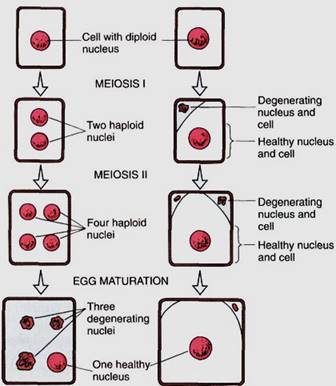
Less Common Types of Division
 المؤلف:
AN INTRODUCTION TO PLANT BIOLOGY-1998
المؤلف:
AN INTRODUCTION TO PLANT BIOLOGY-1998
 المصدر:
JAMES D. MAUSETH
المصدر:
JAMES D. MAUSETH
 الجزء والصفحة:
الجزء والصفحة:
 18-10-2016
18-10-2016
 2274
2274
Less Common Types of Division
Cytokinesis and karyokinesis are often so closely associated that we tend to think of them as two aspects of one process. In numerous tissues, however, karyokinesis occurs without cytokinesis, and multinucleate cells are formed. The nutritive tissue of many seeds goes through a phase in which its cells are multinucleate (Fig. 4.19), and in many algae all the cells are like this. If the cell becomes very large and has hundreds or thousands of nuclei, it is called a coenocyte.
On the other hand, it is possible for cell division to occur without nuclear division; this is most common in algae, fungi, and the nutritive tissues of seeds. The cells become multinucleate and persist in that condition for some time; then cell division begins as new walls are organized around each nucleus and its accompanying cytoplasm (see Fig. 20.13). At present the selective advantage of this behavior is not known.
In meiosis, the processes of cytokinesis and karyokinesis are often not directly linked. In some species, cytokinesis happens after both meiosis I and meiosis II, and four haploid cells result from each original diploid mother cell.


FIGURE 4.20: In animals and some plants, the meiosis that is part of egg production produces only one large haploid cell. (a) In some species, meiosis results in four haploid nuclei; no cytokinesis occurs and all four nuclei are temporarily in one cell until degeneration eliminates three of them. (b) In other species, after meiosis I occurs, cytokinesis places one nucleus in a small cell, and both nucleus and cell degenerate before they can undergo meiosis II. The nucleus of the larger cell does undergo meiosis II, and again one daughter nucleus is placed in a small cell that degenerates. Only three nuclei are ever formed, and only one survives.
cells result from each original diploid mother cell. In other species, no cytokinesis occurs after meiosis I but a double cytokinesis occurs after meiosis II, again resulting in four haploid cells. For example, pollen grains can form either way, and meiosis results in four haploid cells. But in many organisms, no cytokinesis occurs at all during the meiosis that leads to the formation of eggs. The final cell is tetranucleate and may remain that way, or three of the nuclei may degenerate and produce only a single uninucleate haploid egg cell by meiosis (Fig. 4.20). It seems to be selectively advantageous to produce one large egg rather than four small ones.
 الاكثر قراءة في مواضيع عامة في علم النبات
الاكثر قراءة في مواضيع عامة في علم النبات
 اخر الاخبار
اخر الاخبار
اخبار العتبة العباسية المقدسة


